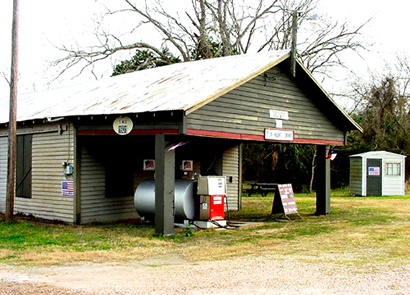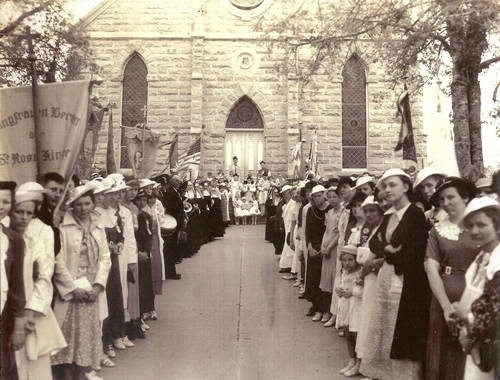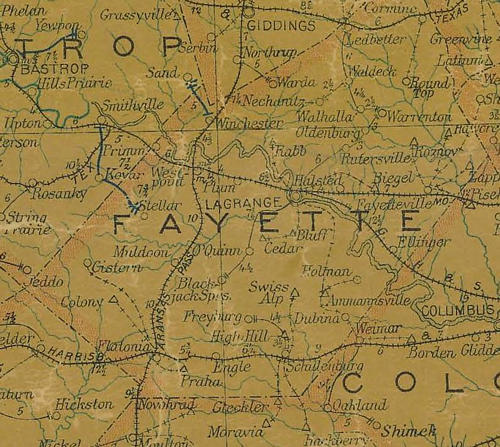Praha, Texas, ghost town and St. Mary's, a painted church. (original) (raw)
Rev. Vaclav Bily's First Mass in Praha, 3-25-1939
Fayette Co Hist Commission; submitted by Carolyn Heinsohn, FCHC member
The town is just south of the railroad tracks that parallel Highway 90. Praha is listed in Lindsay Baker's Ghost Towns of Texas.
Praha is the Czech spelling of Prague. Prior to the coming of the Czechs, Praha was called Mulberry by the Anglo settlers. It's reputation for being a refuge for outlaws gave it the unoffical name of Hotentot.
Praha has a huge gathering every August when thousands descend on the church grounds for a homecoming.
First Communion celebrants at St. Mary's Catholic Church, unknown year
Courtesy Texas Czech Heritage and Cultural Center Photo Collection
Praha History in a Pecan Shell
By Carolyn Heinsohn, Fayette County Historical Commission:
- Located on the southwest edge of Fayette County; first people here were outlaws and misfits.
- The first Bohemian to arrive was Matej Novak in 1855; other Bohemian and Moravian families arrived, especially after the Civil War.
- The town was first called Mulberry, but the name was later changed to Praha, which is the Czech name for Prague, the governing city of Bohemia.
- School was first taught in Novak's home and then others. A public school was built in 1868, but it burned and was replaced. A Catholic school built in 1896 was run by the Sisters of the Divine Providence of San Antonio. It was said to be the first Bohemian Catholic School in America.
- By 1882, there were 200 families.
- Businesses included two saloons, a post office, caf�, herb center, liquor store , blacksmith shop, wheelwright shop, meat market, dance hall, a resident physician, and a cotton gin three miles south of Praha. Later Hajek's Garage opened.
- St. Mary's parish was established in 1865. Mass was first said in Matej Novak's home, but then a small stone chapel was built by the end of 1865. A cemetery was soon established with the first burial in September, 1866.
- A second larger church was built and dedicated to the Assumption of the Blessed Virgin Mary (St. Mary's); by 1876, a third larger church wooden church was built for the growing parish. The present stone church was started in 1892; its ceiling and walls were painted by fresco artist Gottfried Flurry. It was dedicated in 1895 and is now one of the four "Painted Churches of Fayette County".
- The parish annual homecoming, "Prazda Pout" is held every August 15th, the parish feast day at Mother Praha - "Maticka Praha".
- A Veterans' Day Memorial Service is held annually because of the nine native sons of Praha who lost their lives during WWII. - Carolyn Heinsohn

Praha Saloon, 1890
Fayette Co Hist Commission; submitted by Carolyn Heinsohn, FCHC member

The Praha Jolly Club c. 1910
Photo Courtesy E. A. Arnim Archives & Museum of Flatonia; submitted by Carolyn Heinsohn

Musicianans outside the same station shown above. (c. 1931)
Photo Courtesy E. A. Arnim Archives & Museum of Flatonia
One of three identical memorial shrines honoring Praha's men who died in WWII.
TE Photo, 3-01

The last remaining business in Praha.
TE Photo, 3-01
Praha, Texas Chronicles
- Texas War Casualties by John Troesser
Stone markers and chapels quietly reveal where America gets its soldiers. - Rev. Marcus Valenta achieves longest active-duty record in U.S. history by Murray Montgomery
Father Marcus Valenta was one of those exceptional people. He served his God, country, and fellow man without personal regard for his own well being. According to one newspaper, �Father Valenta was a popular and well-known pastor of the Assumption of Blessed Virgin Mary Catholic Church at Praha.� But perhaps his greatest achievement was his service to the U.S. Army � at the time, he had the longest active-duty record in U.S. history. - 9 Boys by David Knape
Texas Escapes, in its purpose to preserve historic, endangered and vanishing Texas, asks that anyone wishing to share their local history, stories, landmarks and contemporary or vintage/historic photos, please contact us.




